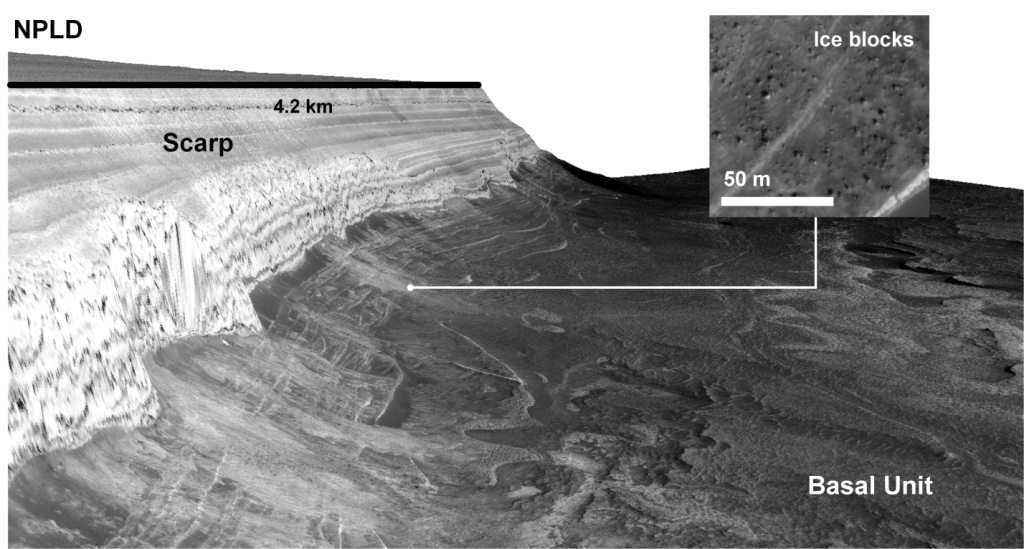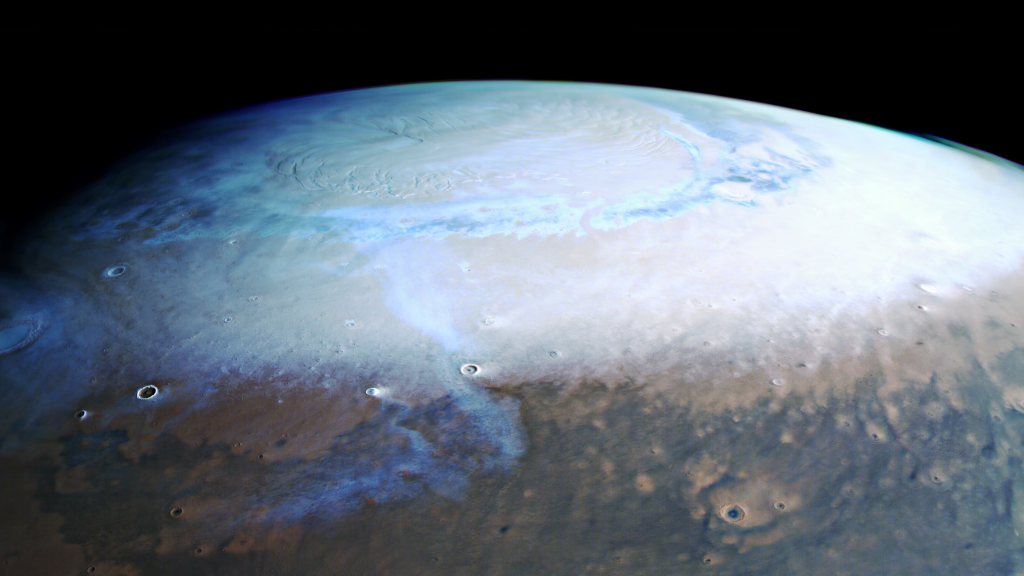Just like Earth, Mars experiences four seasons throughout the year due to the tilt of its rotational axis. During Martian autumn and winter, temperatures in its polar regions can drop below the freezing point of carbon dioxide (around -125°C), which constitutes 95% of Mars’ atmosphere by volume. This carbon dioxide can deposit on the surface of the red planet either by precipitating as snow or directly condensing into frost.

Illustration of the NPLD and ice blocks at the foot of a steep scarp by a 3D view with a HiRISE image acquired during the summertime. Elevation difference from top of the NPLD to the Basal Unit at the bottom is around 600 m. Aprons of debris are visible at the foot of the scarp. Inset map shows typical examples of ice blocks.
Annually, up to a third of atmospheric carbon dioxide exchanges occur between the atmosphere and the Martian surface through a seasonal cycle of deposition and sublimation. These seasonal deposits can extend from the poles to approximately 50° latitude. If Paris were located on Mars, it would be covered by a thin layer of carbon dioxide snow and frost during the winter. This seasonal process represents a crucial volatile cycle on Mars, and its detailed study with high temporal and spatial resolution would significantly contribute to understanding the global dynamics of Martian climate.
Estimating the thickness of this seasonal snow and frost can be key in designing future missions to the Martian surface aimed at deciphering the planet’s paleoclimate by drilling into the so-called North Polar Layered Deposits (NPLD). These deposits are a set of layers of water ice and dust stacked over the Martian North Pole over millions of years. Their record can provide valuable information about the climatic evolution of our neighboring planet from the past to the present.
NEW METHOD FOR MEASURING SNOW THICKNESS ON MARS
In a recent study published in the Journal of Geophysical Research: Planets, our team proposed an innovative approach to estimate the thickness of these seasonal deposits by observing variations in the shadow of large ice blocks. These blocks are formed by fractured ice detachments and remain at the base of the steep scarps present in the NPLD. The thickness of the snow and frost deposited around them varies throughout the different seasons of the Martian year.
Thanks to its impressive spatial resolution of up to 25 cm and a series of reasonable assumptions about the distribution of snow and frost around these blocks, we have unequivocally related the length of the shadow of the ice block to its height. This has allowed us to estimate with great precision the thickness of both the snow and the frost deposited, even in late Martian winter and early spring when the quality of HiRISE images is not as good.
MORE SNOW THAN EXPECTED
This innovative method was tested on a steep scarp located approximately at 85.0°N, 151.5°E of the Martian North Pole. The results showed that the increase in thickness due to seasonal accumulation of snow and frost could reach up to 1.6 meters by late winter, enough to submerge most of the cars, and then gradually decrease as the red planet progresses toward its summer solstice.
The contribution from snow alone is around 1 m. This value is approximately two orders of magnitude greater than the average thickness predicted by recent models of snowfall on Mars, indicating that local storms associated with large accumulations of carbon dioxide may be more frequent and violent than estimated so far.
Additionally, this new approach allowed discerning that the contribution of snowfall to the thickness and volume of the seasonal snow layer during winter is greater compared to direct surface condensation in the form of frost.
Last but not least, the application of our method to a set of HiRISE images from 2008 to 2021 allowed us to detect interannual variations in the thickness of snowfall. In fact, we demonstrated that the snow in 2021 reached a depth approximately 0.36 meters greater than measured a decade earlier, in 2011.
A PROMISING METHOD
In summary, measurements of carbon dioxide snow and frost thickness obtained through this new method, based on the variability of the shadow of large ice blocks on the Martian surface, reveal the dynamics of the Martian volatile cycle and can be used to refine Martian climate models.
We hope that in the future, by applying this method to other Martian locations, we can obtain a complete picture of the evolution of snow and frost on the planet’s surface over the years, as well as its relationship with dust storms and water ice transport.
Detailed info can be found here, Xiao et al, 2024.
Featured image/excerpt: Seasonal snow and frost at the Martian north polar region as seen by the High Resolution Stereo Camera (HRSC) onboard ESA’s Mars Express. Credit: ESA/DLR/FU-Berlin.

